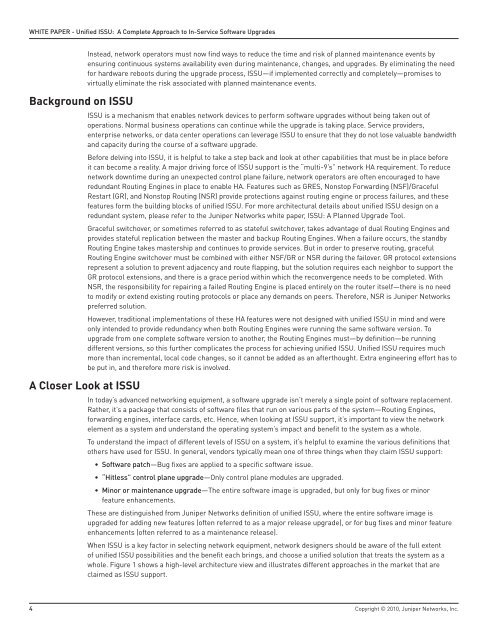Unified ISSU: A Complete Approach to In ... - Juniper Networks
Unified ISSU: A Complete Approach to In ... - Juniper Networks
Unified ISSU: A Complete Approach to In ... - Juniper Networks
Create successful ePaper yourself
Turn your PDF publications into a flip-book with our unique Google optimized e-Paper software.
WHITE PAPER - <strong>Unified</strong> <strong>ISSU</strong>: A <strong>Complete</strong> <strong>Approach</strong> <strong>to</strong> <strong>In</strong>-Service Software Upgrades<br />
Background on <strong>ISSU</strong><br />
A Closer Look at <strong>ISSU</strong><br />
<strong>In</strong>stead, network opera<strong>to</strong>rs must now find ways <strong>to</strong> reduce the time and risk of planned maintenance events by<br />
ensuring continuous systems availability even during maintenance, changes, and upgrades. By eliminating the need<br />
for hardware reboots during the upgrade process, <strong>ISSU</strong>—if implemented correctly and completely—promises <strong>to</strong><br />
virtually eliminate the risk associated with planned maintenance events.<br />
<strong>ISSU</strong> is a mechanism that enables network devices <strong>to</strong> perform software upgrades without being taken out of<br />
operations. Normal business operations can continue while the upgrade is taking place. Service providers,<br />
enterprise networks, or data center operations can leverage <strong>ISSU</strong> <strong>to</strong> ensure that they do not lose valuable bandwidth<br />
and capacity during the course of a software upgrade.<br />
Before delving in<strong>to</strong> <strong>ISSU</strong>, it is helpful <strong>to</strong> take a step back and look at other capabilities that must be in place before<br />
it can become a reality. A major driving force of <strong>ISSU</strong> support is the “multi-9’s” network HA requirement. To reduce<br />
network downtime during an unexpected control plane failure, network opera<strong>to</strong>rs are often encouraged <strong>to</strong> have<br />
redundant Routing Engines in place <strong>to</strong> enable HA. Features such as GRES, Nons<strong>to</strong>p Forwarding (NSF)/Graceful<br />
Restart (GR), and Nons<strong>to</strong>p Routing (NSR) provide protections against routing engine or process failures, and these<br />
features form the building blocks of unified <strong>ISSU</strong>. For more architectural details about unified <strong>ISSU</strong> design on a<br />
redundant system, please refer <strong>to</strong> the <strong>Juniper</strong> <strong>Networks</strong> white paper, <strong>ISSU</strong>: A Planned Upgrade Tool.<br />
Graceful switchover, or sometimes referred <strong>to</strong> as stateful switchover, takes advantage of dual Routing Engines and<br />
provides stateful replication between the master and backup Routing Engines. When a failure occurs, the standby<br />
Routing Engine takes mastership and continues <strong>to</strong> provide services. But in order <strong>to</strong> preserve routing, graceful<br />
Routing Engine switchover must be combined with either NSF/GR or NSR during the failover. GR pro<strong>to</strong>col extensions<br />
represent a solution <strong>to</strong> prevent adjacency and route flapping, but the solution requires each neighbor <strong>to</strong> support the<br />
GR pro<strong>to</strong>col extensions, and there is a grace period within which the reconvergence needs <strong>to</strong> be completed. With<br />
NSR, the responsibility for repairing a failed Routing Engine is placed entirely on the router itself—there is no need<br />
<strong>to</strong> modify or extend existing routing pro<strong>to</strong>cols or place any demands on peers. Therefore, NSR is <strong>Juniper</strong> <strong>Networks</strong><br />
preferred solution.<br />
However, traditional implementations of these HA features were not designed with unified <strong>ISSU</strong> in mind and were<br />
only intended <strong>to</strong> provide redundancy when both Routing Engines were running the same software version. To<br />
upgrade from one complete software version <strong>to</strong> another, the Routing Engines must—by definition—be running<br />
different versions, so this further complicates the process for achieving unified <strong>ISSU</strong>. <strong>Unified</strong> <strong>ISSU</strong> requires much<br />
more than incremental, local code changes, so it cannot be added as an afterthought. Extra engineering effort has <strong>to</strong><br />
be put in, and therefore more risk is involved.<br />
<strong>In</strong> <strong>to</strong>day’s advanced networking equipment, a software upgrade isn’t merely a single point of software replacement.<br />
Rather, it’s a package that consists of software files that run on various parts of the system—Routing Engines,<br />
forwarding engines, interface cards, etc. Hence, when looking at <strong>ISSU</strong> support, it’s important <strong>to</strong> view the network<br />
element as a system and understand the operating system’s impact and benefit <strong>to</strong> the system as a whole.<br />
To understand the impact of different levels of <strong>ISSU</strong> on a system, it’s helpful <strong>to</strong> examine the various definitions that<br />
others have used for <strong>ISSU</strong>. <strong>In</strong> general, vendors typically mean one of three things when they claim <strong>ISSU</strong> support:<br />
• Software patch—Bug fixes are applied <strong>to</strong> a specific software issue.<br />
• “Hitless” control plane upgrade—Only control plane modules are upgraded.<br />
• Minor or maintenance upgrade—The entire software image is upgraded, but only for bug fixes or minor<br />
feature enhancements.<br />
These are distinguished from <strong>Juniper</strong> <strong>Networks</strong> definition of unified <strong>ISSU</strong>, where the entire software image is<br />
upgraded for adding new features (often referred <strong>to</strong> as a major release upgrade), or for bug fixes and minor feature<br />
enhancements (often referred <strong>to</strong> as a maintenance release).<br />
When <strong>ISSU</strong> is a key fac<strong>to</strong>r in selecting network equipment, network designers should be aware of the full extent<br />
of unified <strong>ISSU</strong> possibilities and the benefit each brings, and choose a unified solution that treats the system as a<br />
whole. Figure 1 shows a high-level architecture view and illustrates different approaches in the market that are<br />
claimed as <strong>ISSU</strong> support.<br />
4 Copyright © 2010, <strong>Juniper</strong> <strong>Networks</strong>, <strong>In</strong>c.
















